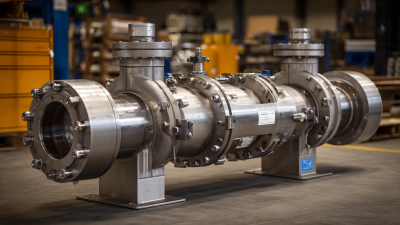Understanding the Functionality of Ball Check Valves in Fluid Control Systems
In the dynamic world of fluid control systems, the ball check valve plays a crucial role in ensuring the efficient and reliable operation of various applications. According to a recent industry report by MarketsandMarkets, the global valve market is expected to reach $80 billion by 2025, with check valves, including ball check valves, contributing significantly to this growth due to their effectiveness in preventing backflow and maintaining system integrity. Ball check valves, characterized by their simple yet effective design, utilize a spherical ball to create a seal, thereby allowing fluid to flow in one direction while preventing reverse flow. This functionality is essential in industries ranging from water treatment to oil and gas, where maintaining consistent flow direction is critical to operational efficiency. Understanding the mechanisms and advantages of ball check valves is vital for engineers and stakeholders looking to optimize their fluid control systems and enhance overall performance.

Key Components of Ball Check Valves and Their Roles
Ball check valves are essential components in fluid control systems, providing a reliable mechanism for preventing backflow. The primary component of a ball check valve is the ball itself, which is held against a seat by the weight of the fluid when flow is present. This design not only allows liquid to flow in one direction but also ensures that if the flow stops or reverses, the ball will automatically seal the opening, thus preventing any reverse flow. According to a report from the Global Market Insights, the ball check valve market is projected to reach USD 2.2 billion by 2027, demonstrating the increasing reliance on these devices in various applications, including water treatment, industrial processes, and HVAC systems.
In addition to the ball, the housing, seat, and spring (if present) are critical components that affect the performance of ball check valves. The housing is designed to withstand high pressures and aggressive fluids, while the seat must provide a reliable sealing surface. Industries often focus on materials that enhance corrosion resistance and durability, such as stainless steel and PVC, to prolong service life. Data from the Engineering Toolbox indicates that ball check valves can significantly reduce maintenance costs in fluid systems by minimizing the risk of leaks and system failures, hence underscoring their vital role in efficient fluid control management.
Understanding the Functionality of Ball Check Valves in Fluid Control Systems - Key Components of Ball Check Valves and Their Roles
| Component | Material | Function | Common Applications |
|---|---|---|---|
| Ball | Stainless Steel / Plastic | Seals the flow when reverse pressure occurs | Pipelines, Pumps |
| Body | Brass / PVC | Supports the internal components and holds the flow | Water Systems, Chemical Processing |
| Spring | Stainless Steel | Provides force to close the ball against flow | Control Systems, HVAC |
| Seal | Rubber / PTFE | Ensures no leakage occurs during operation | Oil and Gas, Water Treatment |
| End Connectors | Various Metals / Plastic | Facilitates attachment to other piping systems | Fluid Transport, Industrial Applications |
How Ball Check Valves Work in Fluid Control Systems
Ball check valves play a crucial role in fluid control systems by ensuring the unidirectional flow of fluids while preventing backflow. Their design typically features a spherical ball that acts as a seal. When fluid flows in the desired direction, the pressure lifts the ball off its seat. However, if there is any reverse flow, the ball will drop back into place, effectively blocking the passage. This automatic function helps maintain system integrity and prevents contamination in piping systems.

The operational mechanics of ball check valves are relatively straightforward yet effective. They are often employed in various applications, including water supply systems, oil rigs, and chemical processing plants. The simplicity of their design allows for easy maintenance and installation, making them an attractive choice for engineers. Moreover, their ability to handle high flow rates and varied pressures makes ball check valves indispensable in ensuring efficient fluid management in complex systems seen in industries like oil extraction and processing.
Advantages of Using Ball Check Valves Over Other Types
Ball check valves have been gaining traction in the industrial sector due to their inherent advantages over other valve types. With the global industrial valves market projected to grow from USD 86.67 billion in 2025 to USD 131.6 billion by 2033, a compound annual growth rate (CAGR) of 6%, industries are increasingly opting for reliable and efficient solutions. Ball check valves stand out by offering superior sealing capabilities, reducing the risk of backflow, and ensuring optimal fluid control. Their simple design and ease of maintenance make them an attractive choice for fluid systems in various applications.
Moreover, the advancements in valve technology are evident with new product offerings that emphasize safety and efficiency. Recent innovations such as cone check valves showcase improved performance features, further solidifying the preference for ball check valves. These enhancements not only cater to conventional fluid processes but also address the unique demands of harsh fluid environments, enabling a wider range of applications. As industries focus on high-performance components, ball check valves are poised to play a pivotal role in the evolution of fluid control systems.
Advantages of Using Ball Check Valves Over Other Types
Common Applications of Ball Check Valves in Various Industries
Ball check valves play a critical role in numerous industries by ensuring fluid flows in one direction while preventing backflow. Their design features a spherical ball that sits in a seat, allowing fluid to push it open during flow and sealing it tightly when flow reverses. This simple yet effective mechanism makes them ideal for a multitude of applications across various sectors.

In the water and wastewater industry, ball check valves are essential for maintaining system integrity and preventing contamination. They are commonly used in sewage treatment plants to stop the reverse flow of treated water, ensuring clean water is unaffected by the dirty influx. Similarly, in the oil and gas sector, these valves help maintain efficient operations by preventing backflow in pipelines, safeguarding both equipment and the surrounding environment. Additionally, in HVAC systems, ball check valves assist in regulating heating and cooling fluids, optimizing energy efficiency and performance. Their versatility and reliability make ball check valves a vital component in fluid control systems across multiple applications.
Maintenance Tips for Ensuring Optimal Performance of Ball Check Valves
Ball check valves are essential components in fluid control systems, serving to prevent backflow and ensure a one-way flow of fluids. However, like any mechanical device, they require regular maintenance to operate optimally. One primary maintenance tip is to conduct routine inspections of the valve's seating area to check for wear or debris accumulation. Ensuring that the valve body and seat are clean promotes a proper seal, which is crucial for preventing leaks and maintaining system pressure.
Another important aspect of maintenance is to monitor the operating conditions of the system, such as pressure and temperature. Sudden changes can affect the valve’s performance and longevity. Ensuring that the valve is suitable for the specific fluid type and operating conditions can prevent premature failure. Additionally, lubricating moving components can help maintain smooth operation and prevent corrosion. Regularly following these maintenance practices can significantly extend the life of ball check valves and enhance the overall efficiency of fluid control systems.
Related Posts
-

How to Optimize Your Pipeline Efficiency with Ball Check Valves: Best Practices and Insights
-

Understanding the Benefits and Applications of Lockable Ball Valves in Industrial Settings
-

Mastering Ball Valve Selection: A Comprehensive Tutorial for Optimal Flow Control in Industrial Applications
-

Common Issues Faced by Global Buyers When Sourcing Gas Valves: A Comprehensive Guide
-

Understanding Industry Standards for the Best Actuator Valve and How to Choose the Right One
-

Ultimate Checklist for Choosing the Right PTFE Valve for Your Industrial Needs
